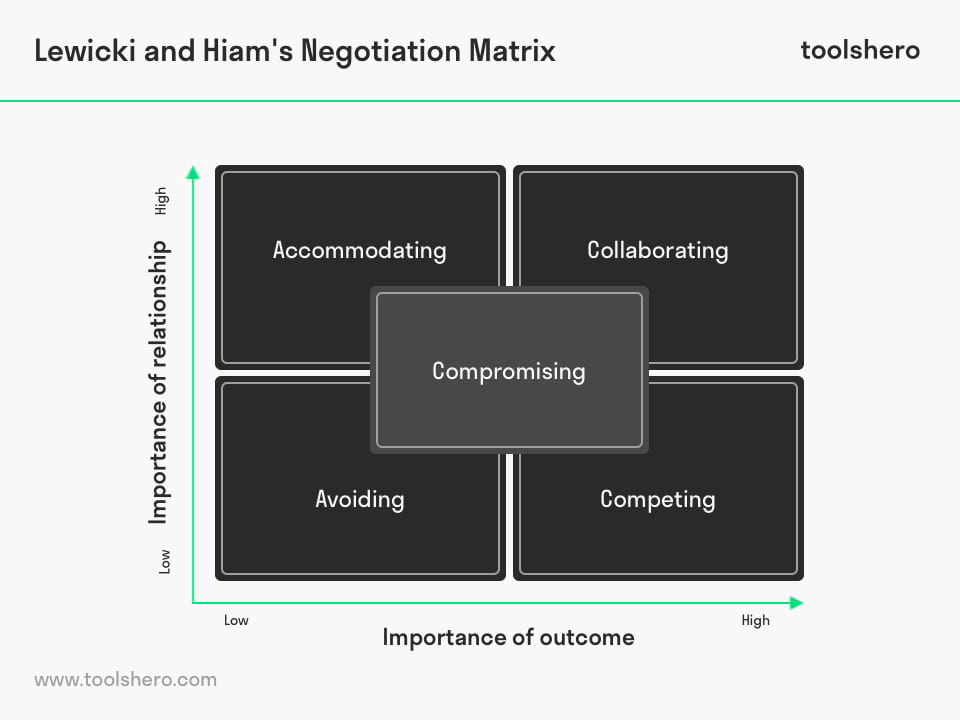Lewicki and Hiam’s Negotiation Matrix

Lewicki and Hiam’s Negotiation Matrix: this article provides a practical explanation of Lewicki and Hiam’s Negotiation Matrix. After reading, you will have a basic understanding of this powerful communication skill.
What is Lewicki and Hiam’s Negotiation Matrix?
Lewicki and Hiam’s Negotiation Matrix is a framework that can be used by individuals to identify an appropriate negotiating style. A negotiating style may differ per situation because of potential interdependencies. Basically, the higher the interdependency, the more sacrifices are made during a negotiation.
Regardless of any negotiation style, preparation is the master key for effective negotiation. The negotiation preparation aims to find potential responses, and it helps to clarify the objectives of a negotiation.
Another reason why negotiation preparation is essential is that it enables clarification of the situation, which helps to find the most suitable negotiating style for the situation.
Lewicki and Hiam’s negotiating matrix identified five negotiating styles: Accommodating, Collaborating, Avoiding, and Competing. Each negotiating method will be explained more in detail below in this article.
All negotiating styles also require a different attitude and behavior of the negotiator. While these are the generally negotiating styles, Lewicki and Hiam’s negotiating matrix also integrates the evaluation of the importance of the relationship and the importance of the outcome. The evaluation of the importance of the relationship and outcome helps to select the most appropriate negotiating style.
Negotiating styles of Lewicki and Hiam’s Negotiation Matrix
The mentioned negotiating styles are generic styles that individuals pursue.
These are often styles that reflect one’s communication style, but it can also be an individual’s intended choice. Experienced negotiators often choose the most appropriate negotiating method for the negotiation.
For example, if a person needs to negotiate with another person with whom they have a meaningful ongoing relationship, the best negotiating style is anything else than the competing negotiating method.
In this scenario, the collaborating negotiating style might be the best alternative because this style reflects the consideration of both parties’ concerns.
In the following section, the negotiating styles of Lewicki and Hiam’s negotiating matrix are explained more in detail.
Competing
This negotiating style of Lewicki and Hiam’s negotiating matrix focus on a win-lose negotiating outcome. Usually, the parties in this type of negotiation put cards on the table to realize the desired objective.
To achieve the desired goal, the parties do not take into account the interest of the opponent party. In the competing negotiating style, the power of the negotiators is always considered. For example, power can be evaluated in terms of dependencies but also in terms of economic power.
This style can be found in businesses that place a high value on specific terms and conditions. Another reason for performing the competing negotiation style of Lewicki and Hiam’s negotiation matrix is that a person with this style can leverage an opponent party’s competing style.
Most of the time, the competing negotiating style is found in competitive industries with single transactions. A typical example of such an industry is the real estate market. In this type of market, building and houses are sold one time, and there is no value placed on building relationships. The purchase situation objectives are to conduct sales as fast as possible in which the buyer seeks to pay the lowest possible price, while the seller attempts to obtain the highest price.
Collaborating
The collaborating negotiating style of Lewicki and Hiam’s negotiating matrix is the opposite of the competing negotiating style. The outcome in this style is focused on a win-win negotiation. Therefore, the collaborating method places a high value on the interest of both parties with the underlying objectives to maintain and improve relationships. Since the relationship is essential, interdependencies can be identified many times.
Building trust is an essential objective of the collaborating negotiation style, as it contributes to building relationships and building a reputation. As time goes by, parties rely on trust that certain agreements will be made. At the same time, parties with a collaborating negotiating style actively seek what kind of implementations positively impact the opponent party or collaborator.
Central in the collaborating negotiating style of Lewicki and Hiam’s negotiating matrix is the style’s open- and honest-attitude style. The goal of this style is to find mutual interest by suggesting creative solutions. The underlying thought is that the parties can achieve higher results.
Compromising
Compromising is a negotiating style of Lewicki and Hiam’s negotiation matrix that focuses on give- and-take. Compromising is many times considered when two parties cannot find an agreement. In this case, give something up to satisfy the other party. Usually, if one party gives something up, the other party does as well. Therefore, the compromising negotiating style is utilized when negotiators cannot fully cooperate but still want to achieve their objectives and maintain the relationship.
Therefore, the compromising style is concerned with the integration of the other four negotiating styles of Lewicki and Hiam’s negotiating matrix. Generally, the party who makes the first compromise loses the most because it enables the other party to obtain a certain degree of insight into the other party’s objectives.
However, to make compromises effectively, the negotiators need to remain flexible to prevent a no-deal solution. On the other hand, sometimes, a no-deal solution can still be a good outcome depending on a BATNA evaluation.
Avoiding
The avoiding negotiation style of Lewicki and Hiam’s negotiation matrix focus on a lose-lose outcome. Negotiators with a preference for an avoiding negotiating style usually dislike conflicts. Opponents are preferably avoided when the cost of negotiating is higher than the result of the negotiation.
However, in some cases, individuals rather avoid negotiation because of the associated stress that could occur. Stress could be caused by the expression of the opponent’s emotions. Examples of emotions that could cause stress are anger or being upset. These types of feelings are triggers for an opponent to avoid a negotiation.
Another consideration to take before adopting the avoiding negotiation style of Lewicki and Hiam’s negotiation matrix is the importance of the relationship and the negotiation outcomes. In case both are not important, the best option might be to avoid negotiation.
Accommodating
This negotiating style of Lewicki and Hiam’s negotiation matrix is concerned with an I-lose, you-win approach. Individuals with a preference for the accommodating negotiating style place great value on maintaining relationships.
These individuals are willing to make compromises in order to provide a benefit to the other party. People with an accommodating negotiating style frequently have a friendly character, and it is in their nature to help others.
For this reason, individuals with this negotiation style of Lewicki and Hiam’s negotiating matrix are valued when negotiating is required in a crisis in which a company needs to rebuild its reputation.
This accommodating style is frequently used to invest in the future. A party can be willing to make a current loss because the acceptance of that loss could help to realize significant growth in the future. Additionally, an accommodating approach can be beneficial to postpone a long-term negotiation. In this way, the party who accommodated in the negotiation creates time to obtain crucial resources that can be used as a strategic move in the next negotiation.
Conclusion on the Lewicki and Hiam’s Negotiation Matrix
Negotiations are held on a daily and individual base in formal and informal situations. While it is often thought that negotiation occurs in formal settings, consider the following example: It’s Monday afternoon around 05:00 PM when Yasmine calls her friend to pick-up an important package that just has been delivered at a pick-up location.
Yasmine is currently preparing dinner, she cannot leave her house, and she needs the package ASAP. Yasmine calls her friend, who almost arrives home from work and need to cook as well.
Yasmine requests her friend to pick up the good. Her friends say that he is starving, and he needs to prepare food. Jasmine offers her friend to have dinner at her home so that he does not have to cook anymore. Her friend agrees to pick up the goods at the pick-up location and have dinner at Jasmine’s place.
The previously described scenario reflects a simple negotiation between two friends. These scenarios occur daily, and it is up to the individuals whose negotiating style reflects one’s communication style.
Experienced negotiators have the knowledge and the ability to easily switch from the negotiation styles of Lewicki and Hiam’s Negotiation Matrix.
These types of negotiators are often found in formal settings. It is crucial to be able to switch negotiation styles to become effective because each method can have a different effect on the other party.
For instance, during the negotiation, it can be noticed that a party becomes more distant. In this case, it could be wise to reevaluate the negotiation style and strategy.
Finally, the best negotiation outcome per party is totally dependent on the parties’ objectives.
If a party places the most value on maintaining the relationship, there is a chance that this party will negotiate with an accommodating negotiating style of the Lewicki and Hiam’s negotiating matrix.
This party could make a trade-off to benefit the other party. The other party might believe its wining, but there is a win-win situation because of different objectives in reality. Therefore, there is no right or wrong negotiation style or outcome. It all depends on the goals of the parties, which can be identified with proper preparation.
Now It’s Your Turn
What do you think? Do you recognize the explanation of strategic change? Do you already continuously monitor technological, political, and cultural dynamics? What you think of managing strategic change? Do you have any tips or additional comments?
Share your experience and knowledge in the comments box below.
More information
- Craver, C. B. (2011). The Impact of Negotiator Styles on Bargaining Interactions. Am. J. Trial Advoc., 35, 1.
- Lewicki, R. J., & Dineen, B. R. (2002). Negotiation in Virtual Organizations. Human resource management in virtual organizations, 263.
- Lewicki, R. J., & Hiam, A. (2011). Mastering business negotiation: a working guide to making deals and resolving conflict. John Wiley & Sons.
- Lewicki, R. J., Hiam, A., & Olander, K. W. (1996). Think before you speak: A complete guide to strategic negotiation. John Wiley & Sons
- Mueller, J. S., & Curhan, J. R. (2006). Emotional intelligence and counterpart mood induction in a negotiation. International journal of conflict management, 17(2), 110-128.
- Owens, S. D., & Webster Jr, F. M. (2004). Negotiating Skills for Project Managers. Field Guide to Project Management, 368.
- Schneider, A. K. (2012). Teaching a new negotiation skills paradigm. Wash. UJL & Pol’y, 39, 13.
- Smeltzer, L. R., Manship, J. A., & Rossetti, C. L. (2003). An analysis of the integration of strategic sourcing and negotiation planning. Journal of Supply Chain Management, 39(3), 16-25.
How to cite this article:
Zeeman, A. (2020). Lewicki and Hiam’s Negotiation Matrix. Retrieved [insert date] from Toolshero: https://www.toolshero.com/communication-methods/lewicki-and-hiams-negotiation-matrix/
Published on: 10/16/2020 | Last update: 05/19/2022
Add a link to this page on your website:
<a href=”https://www.toolshero.com/communication-methods/lewicki-and-hiams-negotiation-matrix/”>Toolshero: Lewicki and Hiam’s Negotiation Matrix</a>











